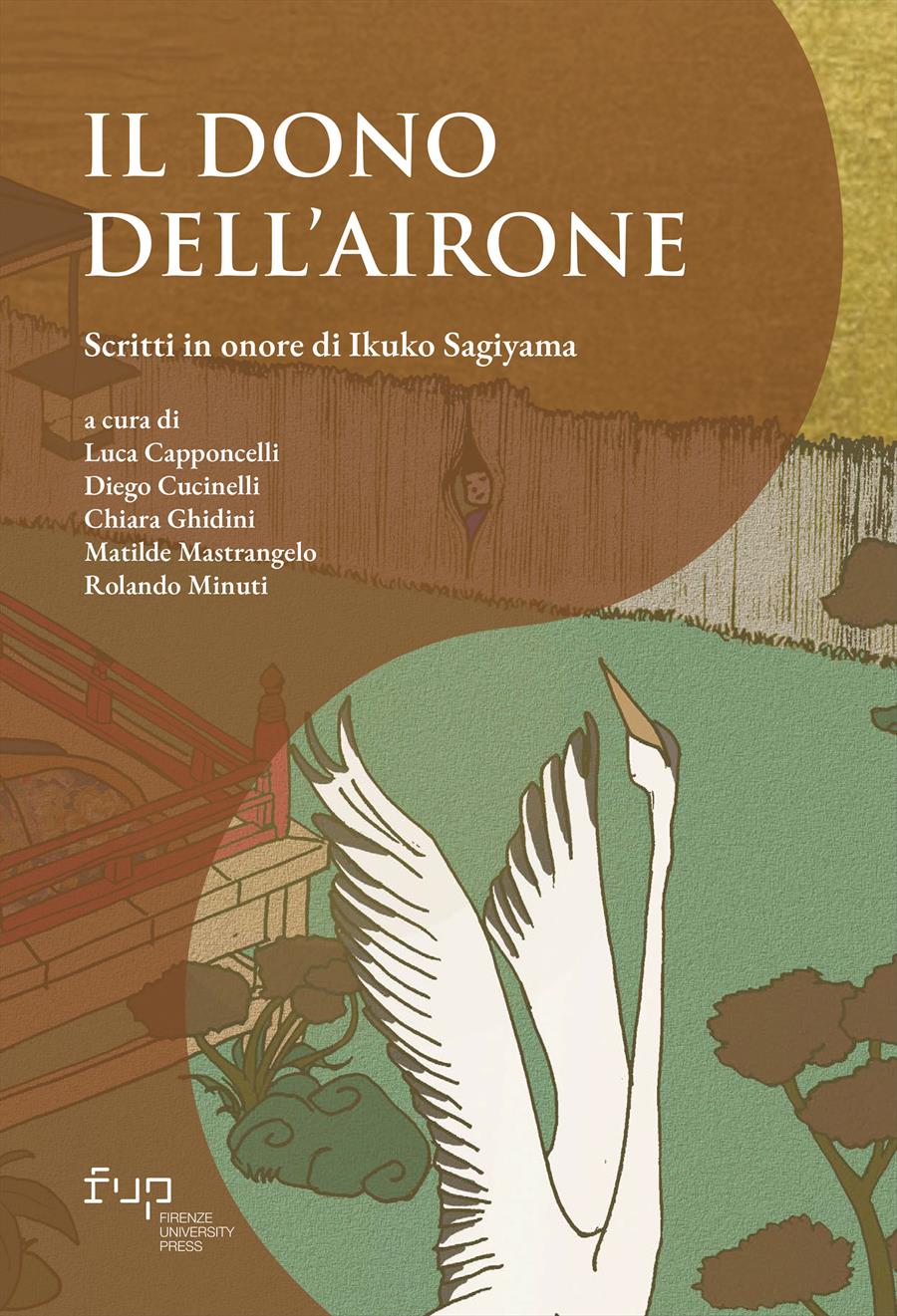- Il dono dell’airone
- Edited by Luca Capponcelli, Diego Cucinelli, Chiara Ghidini, Matilde Mastrangelo, Rolando Minuti
Bikini nel bakumatsu, intimi anacronismi. Il caso di Ōka Sabaki
- Luca Paolo Bruno
- © 2024 Author(s) |
- CC BY 4.0
- DOI: 10.36253/979-12-215-0422-4.26
Japanese Adult Computer Games feature a plethora of setting and themes, ranging from science fiction and fantasy to romantic comedies set in present-day Japan. A subset of these video games features historical or pseudo-historical backdrops for their narratives. An illustrative instance of this approach is the bakumatsu period in Japan, characterized by its unique societal mores and representational affordances. Despite such a setup, this video games remain firmly entrenched in anime-manga industry conventions. This brief contribution explores how these industry practices take precedence over strict adherence to historical accuracy, and what this means for approaches based in Japanese studies.
- Keywords:
- adaruto gēmu,
- Game Studies,
- Japanese Studies,
- Character Intimacy,
- Anime-manga Media,
University of Florence, Italy - ORCID: 0000-0002-3172-8358
- Andlauer, Leticia. 2018. “Pursuing One’s Own Prince: Love’s Fantasy in Otome Game Contents and Fan Practice.” Mechademia: Second Arc 11 (1): 166-83.
- Azuma, Hiroki. 2007. Gemu Teki Riarizumu No Tanjo: Dobutsuka Suru Posutomodan 2. Tōkyō: Kōdansha.
- Azuma, Hiroki. 2009 [2001]. Otaku: Japan’s Database Animals. Translated by Jonathan Able and Sion Kono. Minneapolis (MN): University of Minnesota Press.
- Bruno, Luca. 2019. “The Element Factor. The Concept Of› Character‹ as a Unifying Perspective for the Akihabara Cultural Domain.” IMAGE Journal of Interdisciplinary Image Science 29 (1, Special): 38-59.
- Dahlberg-Dodd, Hannah E. 2020. “O-Jōsama Kotoba and a Stylistics of Same-Sex Desire in Japanese Yuri Narratives.” Mechademia: Second Arc 13 (1): 6-23.
- Galbraith, Patrick W. 2019. Otaku and the Struggle for Imagination in Japan. Duke University Press.
- Galbraith, Patrick W. 2021a. The Ethics of Affect: Lines and Life in a Tōkyō Neighborhood. Stockholm University Press.
- Galbraith, Patrick W. 2021b. “‘For Japan Only?’ Crossing and Re-Inscribing Boundaries in the Circulation of Adult Computer Games.” In Media Technologies for Work and Play in East Asia: Critical Perspectives on Japan and the Two Koreas. Bristol: Bristol University Press.
- Hichibe, Nobushige. 2006. “Bunkasōzō No Jōken – 2-Tsu No Gēmu ‘ba’ No Bunka Seisanronteki Kōsatsu Kara.” Bulletin of the Graduate Division of Letters, Arts and Sciences of Waseda University. I, Philosophy, Oriental Philosophy, Psychology, Sociology, Education 51: 65-73.
- Ishida, Minori. 2014. “Sentō Bishōjo to Sakebi, Soshite Yuri.” Eureka 12: 181-89.
- Ishida, Minori. 2019. “Sounds and Sighs: ‘Voice Porn’ for Women.” In Shōjo Across Media: Exploring" Girl" Practices in Contemporary Japan, 283–99. Cham: Palgrave Macmillan.
- Jiang, Yehang. 2019. “Bishuaru Noberu ni Okeru Kōzō To Sono Riaritī: Gēmu Dezain to Gēmupurei Wo Megutte.” Core Ethics 15: 35-46.
- Kagami, Hiroyuki. 2010. Hijitsuzai Seishōnen Ron: Otaku to Shihonshugi. Tōkyō: Ai’ikusha.
- Kim, Hyeshin. 2009. “Women’s Games in Japan: Gendered Identity and Narrative Construction.” Theory, Culture & Society 26 (2–3): 165-88.
- Kinsella, Sharon. 1995. “Cuties in Japan.” In Women, Media and Consumption in Japan, edited by Lise Skow and Brian Moeran, 220-54. Londra: Routledge.
- Kinsui, Satoshi. 2003. Bācharu Nihongo: Yakuwarigo No Nazo. Tōkyō: Iwanami Shoten.
- Koyama, Yūsuke. 2020. Nihongēmusangyōshi. Gēmusofuto no Kyojintachi. Tōkyō: NikkeiBP.
- Liebers, Nicole, and Holger Schramm. 2019. “Parasocial Interactions and Relationships with Media Characters – An Inventory of 60 Years of Research.” Communication Research Trends 38 (2): 4-31.
- Nittono, Hiroshi. 2016. “The Two-Layer Model of ‘Kawaii’: A Behavioural Science Framework for Understanding Kawaii and Cuteness.” East Asian Journal of Popular Culture 2 (1): 79-95.
- Nozawa, Shunsuke. 2016. “Ensoulment and Effacement in Japanese Voice Acting.” In Media Convergence in Japan, a cura di Patrick W. Galbraith e Jason G. Karlin, 169–199. New Haven (CT): Kinema Club.
- Nozawa, Shunsuke. 2018. “Gengo No Kyarakutā-Ka: Yūgi-Teki Hon’yaku to in’yō.” Kyara Gainen No Hirogari to Fukamari Ni Mukete 1: 217-36.
- Okabe, Tsugumi, and Jérémie Pelletier-Gagnon. 2019. “Playing with Pain the Politics of Asobigokoro in Enzai Falsely Accused.” Journal of the Japanese Association for Digital Humanities 4 (1): 37-53.
- Saito, Kumiko. 2021. “From Novels to Video Games: Romantic Love and Narrative Form in Japanese Visual Novels and Romance Adventure Games.” In Arts 10 (42). Basilea: Multidisciplinary Digital Publishing Institute.
- Santos, Kristine Michelle L. 2020a. “Queer Affective Literacies: Examining ‘Rotten’ Women’s Literacies in Japan.” Critical Arts 34 (5): 72-86.
- Santos, Kristine Michelle L. 2020b. “The Bitches of Boys Love Comics: The Pornographic Response of Japan’s Rotten Women.” Porn Studies 7 (3): 279-90.
- Sasakibara, Gō. 2004. “Bishōjo” No Gendai Shi: “Moe” to Kyarakutā. Tōkyō: Kōdansha.
- Sato, Kumiko. 2009. “A Postwar Cultural History of Cuteness in Japan.” Education about Asia 14 (2): 38-42.
- Suzumoto, Yuichi. 2008. Noberu Gēmu no Shinario Sakusei Gihō Dainiban. Tōkyō: Shuwa System.
- Taylor, Emily. 2007. “Dating-Simulation Games: Leisure and Gaming of Japanese Youth Culture.” Southeast Review of Asian Studies 29.
- Teshigawara, Mihoko, and Satoshi Kinsui. 2011. “Modern Japanese’Role Language’(Yakuwarigo): Fictionalised Orality in Japanese Literature and Popular Culture.” Sociolinguistic Studies 5 (1): 37.
- Unser-Schutz, Giancarla. 2015. “Influential or Influenced? The Relationship between Genre, Gender and Language in Manga.” Gender and Language 9 (2): 223-54.
- Zoltan, Kacsuk. 2016. “From Geek to Otaku Culture and Back Again: The Role of Subcultural Clusters in the International Dissemination of Anime-Manga Culture as Seen through Hungarian Producers.” Dissertazione Dottorale. Kyōto Seika University.
Chapter Information
Chapter Title
Bikini nel bakumatsu, intimi anacronismi. Il caso di Ōka Sabaki
Authors
Luca Paolo Bruno
Language
Italian
DOI
10.36253/979-12-215-0422-4.26
Peer Reviewed
Publication Year
2024
Copyright Information
© 2024 Author(s)
Content License
Metadata License
Bibliographic Information
Book Title
Il dono dell’airone
Book Subtitle
Scritti in onore di Ikuko Sagiyama
Editors
Luca Capponcelli, Diego Cucinelli, Chiara Ghidini, Matilde Mastrangelo, Rolando Minuti
Peer Reviewed
Number of Pages
390
Publication Year
2024
Copyright Information
© 2024 Author(s)
Content License
Metadata License
Publisher Name
Firenze University Press
DOI
10.36253/979-12-215-0422-4
ISBN Print
979-12-215-0421-7
eISBN (pdf)
979-12-215-0422-4
Series Title
Connessioni. Studies in Transcultural History
Series ISSN
2975-0393
Series E-ISSN
2975-0261
